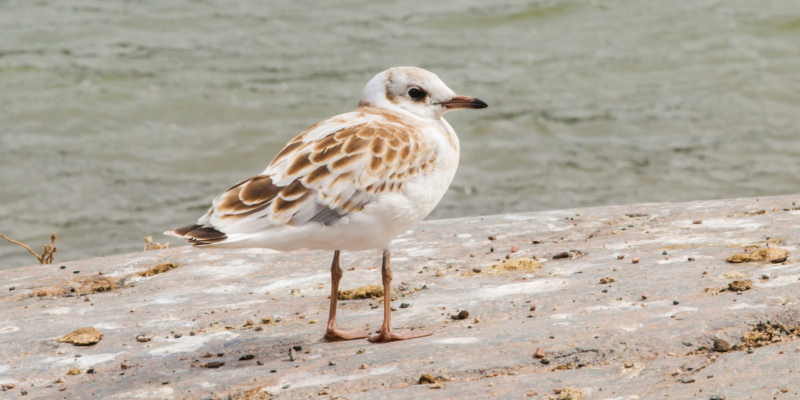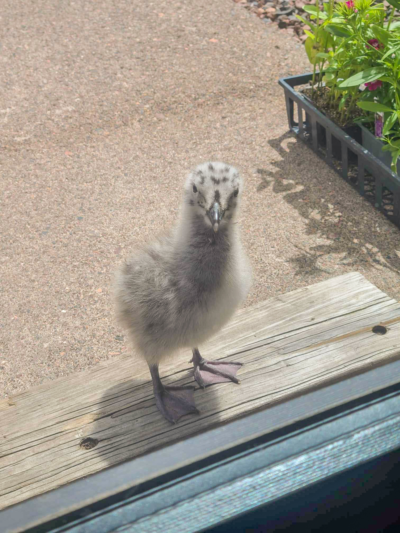
As early summer arrives, so does a familiar sight along coastal areas and lakeshores: seagulls nesting and caring for their newborn seagull chicks. These graceful birds, often misunderstood and sometimes seen as pests, play a crucial role in coastal ecosystems. Understanding their behavior and knowing how to respectfully interact with them during this sensitive time is essential for their well-being… and yours.
June is Nesting Season!
Seagulls typically nest in colonies on coastal cliffs, rooftops, or even on isolated beaches. In Grand Marais many nests can be spotted on the rooftops of various building in the downtown area. In the spring, they build nests. Their nests are often simple scrapes in the ground or rudimentary structures made mostly from grass and scraps. In early June, these nests become bustling nurseries as adult seagulls tend to their fluffy, vulnerable chicks.
As the seagull chicks grow up into fledglings, some get a little ahead of themselves and end up falling off of their rooftop nest a little prematurely. Believe it or not, seagull parents will continue to care for a chick that has fallen down too early, and will also protect it, if needed. If you see a chick on the ground, do not approach is or attempt to help it. The parents are likely nearby, and they do not take kindly to interference with their babies.
Be Respectful… Seriously. It’s the Law.
 Seagulls, like all wildlife, are protective of their young. Disturbing nesting sites or getting too close to seagull chicks can agitate adult birds, leading to adult seagulls to defend their nests. Seagulls in Grand Marais have been spotted dive bombing and purposefully pooping on those who messed with their chicks. Even worse, interference can often lead to stress and potential abandonment of nests. Not to mention, seagulls are protected under various wildlife conservation laws, making it illegal and unethical to harm or disturb them.
Seagulls, like all wildlife, are protective of their young. Disturbing nesting sites or getting too close to seagull chicks can agitate adult birds, leading to adult seagulls to defend their nests. Seagulls in Grand Marais have been spotted dive bombing and purposefully pooping on those who messed with their chicks. Even worse, interference can often lead to stress and potential abandonment of nests. Not to mention, seagulls are protected under various wildlife conservation laws, making it illegal and unethical to harm or disturb them.
However, it is inevitable that you will encounter a seagull if you visit downtown Grand Marais in the summer time. They can be sneaky and seem fearless, especially if you have food and are just trying to enjoy a nice picnic outdoors. And, as you’re strolling around town during fledgling season, there’s a very small chance you may witness a seagull chick’s first attempt at flight. Which, we can only imagine is a majestic and not-at-all-akward sight. So here are some tips for how to be respectful and behave around seagull chicks and fledglings.
How to Behave Around Seagull Chicks and Fledglings
- Keep a Safe Distance: It’s tempting to approach seagull chicks for a closer look, but it’s crucial to maintain a respectful distance of at least 100 feet. This distance ensures that adult birds do not feel threatened or stressed. If they end up in a more-traveled footpath, just do your best to move around them as far as you can, and encourage others to do the same.
- Observe Quietly: If you’re observing seagulls, keep noise to a minimum. Loud noises can startle both chicks and adult birds, potentially causing them to abandon their nests or chicks. Our Grand Marais seagulls are pretty used to people and loud noises, but unexpected noises and fast movements still frighten them.
- Do Not Feed Them: Feeding seagulls, especially near nesting sites, can disrupt their natural feeding habits and may lead to dependency on human food sources, which is harmful to their health. Plus, our food, in general, is not great for seagulls.
- Keep Pets Leashed: If you’re walking a dog near a seagull nesting area, keep your pet on a leash. Unrestrained dogs can disturb nests, injure chicks, or provoke defensive actions from adult birds.
- Respect Legal Restrictions: It is against Minnesota state law to mess with the seagulls. And it’s always best to follow the law!
Enjoying Seagulls Responsibly
Watching seagulls care for their chicks can be a delightful and educational experience. By respecting their space and behaving responsibly, you can ensure that these magnificent birds continue to thrive in their natural habitats. Remember, our actions as observers can significantly impact the well-being of wildlife, especially during critical moments like the nesting season.
Seagulls are fascinating creatures that contribute to the rich tapestry of the Great Lakes ecosystems. As they care for their young in early summer, it’s our responsibility to admire them from a respectful distance and allow them the peace and space they need to raise their wee little seagull chicks successfully. By following these simple guidelines, we can ensure that both seagulls and humans can coexist harmoniously along the North Shore.
